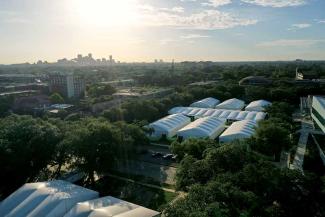When I last wrote in this space, I began with a quote from Sen. Daniel Patrick Moynihan, “The way to build a great city is to create a great university and wait 200 years.”
With Tulane at 186 years old and New Orleans at 300, I declared that the time was now for Tulane to join civic and business leaders in transforming our hometown into a startup leader, a healthcare and biotech hub and home to a diverse mix of entrepreneurs, artists and innovators.
The Spring Tulanian, which included this message, never happened. Blame COVID-19. But Tulane’s impact on the city and the world only increased with our researchers seeking COVID-19 treatments and a vaccine, our medical professionals caring for COVID-19 patients, our epidemiologists assisting the World Health Organization and more. The urgency of these efforts was a major reason we returned to campus for in-person instruction and operations this fall. With its deep relational culture, hands-on learning and research and its location in one of the world’s most culturally and environmentally significant regions, Tulane benefits greatly from the physical presence of its campus population.































































